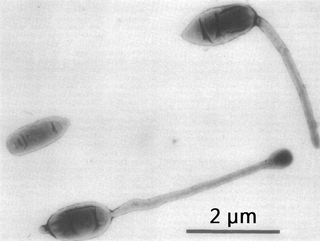Related Research Articles

UniProt is a freely accessible database of protein sequence and functional information, many entries being derived from genome sequencing projects. It contains a large amount of information about the biological function of proteins derived from the research literature. It is maintained by the UniProt consortium, which consists of several European bioinformatics organisations and a foundation from Washington, DC, United States.
Achromobacter cycloclastes is a Gram-negative, aerobic bacterium from the genus Achromobacter. The complete genome of A. cycloclastes has been sequenced.
Achromobacter obae is a bacterium from the genus Achromobacter which contains the enzyme alpha-amino-epsilon-caprolactam racemase. The complete genome of A. obae has been sequenced.
Achromobacter piechaudii is a Gram-negative, aerobic, oxidase-positive, rod-shaped, motile bacterium from the genus Achromobacter. The complete genome of A. piechaudii has been sequenced.

Achromobacter xylosoxidans is a Gram-negative, aerobic, oxidase and catalase-positive, motile bacterium with peritrichous flagella, from the genus Achromobacter. It is generally found in wet environments. Achromobacter xylosoxidans can cause infections such as bacteremia, especially in patients with cystic fibrosis. In 2013, the complete genome of an A. xylosoxidans strain from a patient with cystic fibrosis was sequenced.
Advenella kashmirensis is a chemolithotrophic, mesophilic, neutrophilic, tetrathionate-oxidizing bacterium of the genus Advenella, isolated from the soil of a temperate orchard in Jammu and Kashmir in India. Tetrathiobacter kashmirensis has been reclassified to Advenella kashmirensis. The complete genome of A. kashmirensis has been sequenced.
Alcaligenes denitrificans is a Gram-negative, oxidase- and catalase-positive, strictly aerobic, motile bacterium with peritrichous flagella, from the genus Alcaligenes. Based on 16S rDNA sequence analysis and the low degree of DNA relatedness between other members of Achromobacter species, Yabuuchi et al propose that Alcaligenes denitrificans should be classified as a subspecies of 'Achromobacter xylosoxidans.
Bartonella rattimassiliensis is a bacterium from the genus of Bartonella which was isolated from the rat Rattus norvegicus.
Beijerinckia indica is a nitrogen fixing, aerobic acidophilic bacteria from the genus of Beijerinckia.
Nitrobacter hamburgensis is a gram-negative bacteria from the genus of Nitrobacter.

Hyphomicrobium is a genus of Gram-negative, non-spore-forming, rod-shaped bacteria from the family of Hyphomicrobiaceae. It has a large polar or sub-polar filiform prostheca very similar to that of Caulobacter. In addition to having a nutritional function, the prostheca also plays a role in the initiation of DNA replication.
Streptomyces auratus is a bacterium species from the genus of Streptomyces. Streptomyces auratus produces neophoslactomycin A, lysolipins I and lysolipins X.
Streptomyces iranensis is a bacterium species from the genus of Streptomyces which has been isolated from rhizospherical soil in Isfahan in Iran.
Streptomyces sulphureus is a bacterium species from the genus of Streptomyces which has been isolated from marine sediments in Dalian in China.
Streptomyces vitaminophilus is a bacterium species from the genus of Streptomyces which has been isolated from soil in the Nagano City in Japan. Streptomyces vitaminophilus produces the pyrrolomycin complex.
Arthrobacter koreensis is an alkalitolerant bacterium species from the genus of Arthrobacter which has been isolated from soil from the city Daejon in Korea.
Methylobacterium aquaticum is a bacterium from the genus of Methylobacterium which has been isolated from drinking water in Seville in Spain.
Glaciecola is an aerobic bacteria genus from the family of Alteromonadaceae.
Erythrobacter is a Gram-negative and rod-shaped bacteria genus from the family of Sphingomonadaceae.
Oceanobacillus is a Gram-positive, rod-shaped and motile bacteria genus from the family of Bacillaceae with a peritrichous flagella.
References
| This Betaproteobacteria-related article is a stub. You can help Wikipedia by expanding it. |